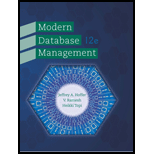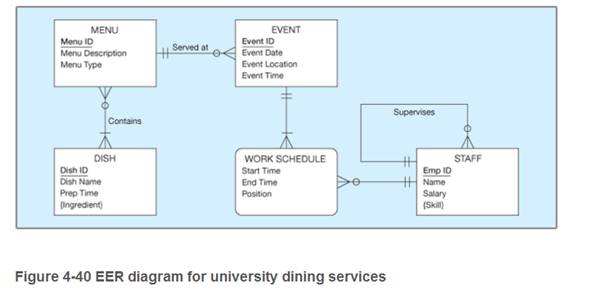
Modern Database Management (12th Edition)
12th Edition
ISBN: 9780133544619
Author: Jeffrey A. Hoffer, Ramesh Venkataraman, Heikki Topi
Publisher: PEARSON
expand_more
expand_more
format_list_bulleted
Concept explainers
Textbook Question
Chapter 4, Problem 4.53PAE
Figure 4-40 shows an EER diagram for a university dining service organization that provides dining services to a major university.
- Transform the EER diagram to a set of relations and develop a relational schema.
- Diagram the functional dependencies and determine the normal form for each relation.
- Convert all relations to third normal form, if necessary, and draw a revised relational schema.

Expert Solution & Answer
Want to see the full answer?
Check out a sample textbook solution
Students have asked these similar questions
I want to ask someone who has experiences in writing physics based simulation software. For context I am building a game engine, and want to implement physics simulation. There are a few approaches that I managed to find, but would like to know what are other approaches to doing physics simulation entry points from scenes, would you be able to visually draw me a few approaches (like 3 approaces)?When I say entry point to the actual physics simulation. An example of this is when the user presses the play button in the editor, it starts and initiates the physics system. Applying all of the global physics settings parameters that gets applied to that scene.Here is the use-case, I am looking for. If you have two scenes, and select scene 1. You press the play button. The physics simulation starts. When that physics simulation starts, you are also having to update the physics through some physics dedicated delta time because physics needs to happen faster update frequency.To elaborate, what…
Male comedians were typically the main/dominant star of television sitcoms made during the FCC licensing freeze.
Question 19 options:
True
False
In the episode of The Honeymooners that you watched this week, why did Alice decide to get a job outside of the home?
Question 1 options:
to earn enough money to buy a mink coat
to have something to do while the kids were at school
to pay the bills after her husband got laid off
After the FCC licensing freeze was lifted, sitcoms featuring urban settings and working class characters became far less common.
Question 14 options:
True
False
Chapter 4 Solutions
Modern Database Management (12th Edition)
Ch. 4 - Prob. 4.1RQCh. 4 - Prob. 4.2RQCh. 4 - Prob. 4.3RQCh. 4 - Describe the primary differences between the...Ch. 4 - Summarize six important properties of relations.Ch. 4 - Describe two properties that each candidate key...Ch. 4 - Describe the three types of anomalies that can...Ch. 4 - Demonstrate each of the anomaly types with an...Ch. 4 - Fill in the blanks in each of the following...Ch. 4 - What is a well-structured relation? Why are...
Ch. 4 - Prob. 4.11RQCh. 4 - Describe how the following components of an E-R...Ch. 4 - Prob. 4.13RQCh. 4 - Prob. 4.14RQCh. 4 - Briefly describe four typical problems that often...Ch. 4 - Prob. 4.16RQCh. 4 - Explain how each of the following types of...Ch. 4 - Prob. 4.18RQCh. 4 - Prob. 4.19RQCh. 4 - Prob. 4.20RQCh. 4 - Prob. 4.21RQCh. 4 - What is the relationship between the primary key...Ch. 4 - Prob. 4.23RQCh. 4 - Explain what can be done with primary keys to...Ch. 4 - Prob. 4.25RQCh. 4 - Explain three conditions that suggest a surrogate...Ch. 4 - Prob. 4.27RQCh. 4 - For each of the following E-R diagrams from...Ch. 4 - Prob. 4.29PAECh. 4 - Prob. 4.30PAECh. 4 - For your answers to the following Problems and...Ch. 4 - Figure 4-3212 shows a class list for Millennium...Ch. 4 - Prob. 4.33PAECh. 4 - Prob. 4.34PAECh. 4 - Prob. 4.35PAECh. 4 - Prob. 4.36PAECh. 4 - Prob. 4.37PAECh. 4 - Prob. 4.38PAECh. 4 - For your answers to the following Problems and...Ch. 4 - Transform Figure 2-15a, attribute version, to 3NF...Ch. 4 - Prob. 4.41PAECh. 4 - Prob. 4.42PAECh. 4 - Prob. 4.43PAECh. 4 - Prob. 4.44PAECh. 4 - For your answers to Problem and Exercise 3-33 from...Ch. 4 - Prob. 4.46PAECh. 4 - Prob. 4.47PAECh. 4 - Figure 4-38 includes an EER diagram for a...Ch. 4 - Prob. 4.49PAECh. 4 - Prob. 4.50PAECh. 4 - Prob. 4.51PAECh. 4 - Prob. 4.52PAECh. 4 - Figure 4-40 shows an EER diagram for a university...Ch. 4 - Explore the data included in Table 4-9. Assume...Ch. 4 - Prob. 4.55PAECh. 4 - Prob. 4.56PAECh. 4 - Prob. 4.57PAECh. 4 - Prob. 4.58PAE
Knowledge Booster
Learn more about
Need a deep-dive on the concept behind this application? Look no further. Learn more about this topic, computer-science and related others by exploring similar questions and additional content below.Similar questions
- solve this questions for me .arrow_forwarda) first player is the minimizing player. What move should be chosen?b) What nodes would not need to be examined using the alpha-beta pruning procedure?arrow_forwardConsider the problem of finding a path in the grid shown below from the position S to theposition G. The agent can move on the grid horizontally and vertically, one square at atime (each step has a cost of one). No step may be made into a forbidden crossed area. Inthe case of ties, break it using up, left, right, and down.(a) Draw the search tree in a greedy search. Manhattan distance should be used as theheuristic function. That is, h(n) for any node n is the Manhattan distance from nto G. The Manhattan distance between two points is the distance in the x-directionplus the distance in the y-direction. It corresponds to the distance traveled along citystreets arranged in a grid. For example, the Manhattan distance between G and S is4. What is the path that is found by the greedy search?(b) Draw the search tree in an A∗search. Manhattan distance should be used as thearrow_forward
- whats for dinner? pleasearrow_forwardConsider the follow program that prints a page number on the left or right side of a page. Define and use a new function, isEven, that returns a Boolean to make the condition in the if statement easier to understand. ef main() : page = int(input("Enter page number: ")) if page % 2 == 0 : print(page) else : print("%60d" % page) main()arrow_forwardWhat is the correct python code for the function def countWords(string) that will return a count of all the words in the string string of workds that are separated by spaces.arrow_forward
- Consider the following program that counts the number of spaces in a user-supplied string. Modify the program to define and use a function, countSpaces, instead. def main() : userInput = input("Enter a string: ") spaces = 0 for char in userInput : if char == " " : spaces = spaces + 1 print(spaces) main()arrow_forwardWhat is the python code for the function def readFloat(prompt) that displays the prompt string, followed by a space, reads a floating-point number in, and returns it. Here is a typical usage: salary = readFloat("Please enter your salary:") percentageRaise = readFloat("What percentage raise would you like?")arrow_forwardassume python does not define count method that can be applied to a string to determine the number of occurances of a character within a string. Implement the function numChars that takes a string and a character as arguments and determined and returns how many occurances of the given character occur withing the given stringarrow_forward
- Consider the ER diagram of online sales system above. Based on the diagram answer the questions below, a) Based on the ER Diagram, determine the Foreign Key in the Product Table. Just mention the name of the attribute that could be the Foreign Key. b) Mention the relationship between the Order and Customer Entities. You can use the following: 1:1, 1:M, M:1, 0:1, 1:0, M:0, 0:M c) Is there a direct relationship that exists between Store and Customer entities? Answer Yes/No? d) Which of the 4 Entities mention in the diagram can have a recursive relationship? e) If a new entity Order_Details is introduced, will it be a strong entity or weak entity? If it is a weak entity, then mention its type?arrow_forwardNo aiarrow_forwardGiven the dependency diagram of attributes {C1,C2,C3,C4,C5) in a table shown in the following figure, (the primary key attributes are underlined)arrow_forward
arrow_back_ios
SEE MORE QUESTIONS
arrow_forward_ios
Recommended textbooks for you
 Database Systems: Design, Implementation, & Manag...Computer ScienceISBN:9781305627482Author:Carlos Coronel, Steven MorrisPublisher:Cengage Learning
Database Systems: Design, Implementation, & Manag...Computer ScienceISBN:9781305627482Author:Carlos Coronel, Steven MorrisPublisher:Cengage Learning Database Systems: Design, Implementation, & Manag...Computer ScienceISBN:9781285196145Author:Steven, Steven Morris, Carlos Coronel, Carlos, Coronel, Carlos; Morris, Carlos Coronel and Steven Morris, Carlos Coronel; Steven Morris, Steven Morris; Carlos CoronelPublisher:Cengage Learning
Database Systems: Design, Implementation, & Manag...Computer ScienceISBN:9781285196145Author:Steven, Steven Morris, Carlos Coronel, Carlos, Coronel, Carlos; Morris, Carlos Coronel and Steven Morris, Carlos Coronel; Steven Morris, Steven Morris; Carlos CoronelPublisher:Cengage Learning A Guide to SQLComputer ScienceISBN:9781111527273Author:Philip J. PrattPublisher:Course Technology Ptr
A Guide to SQLComputer ScienceISBN:9781111527273Author:Philip J. PrattPublisher:Course Technology Ptr
 Principles of Information Systems (MindTap Course...Computer ScienceISBN:9781305971776Author:Ralph Stair, George ReynoldsPublisher:Cengage Learning
Principles of Information Systems (MindTap Course...Computer ScienceISBN:9781305971776Author:Ralph Stair, George ReynoldsPublisher:Cengage Learning Fundamentals of Information SystemsComputer ScienceISBN:9781337097536Author:Ralph Stair, George ReynoldsPublisher:Cengage Learning
Fundamentals of Information SystemsComputer ScienceISBN:9781337097536Author:Ralph Stair, George ReynoldsPublisher:Cengage Learning

Database Systems: Design, Implementation, & Manag...
Computer Science
ISBN:9781305627482
Author:Carlos Coronel, Steven Morris
Publisher:Cengage Learning

Database Systems: Design, Implementation, & Manag...
Computer Science
ISBN:9781285196145
Author:Steven, Steven Morris, Carlos Coronel, Carlos, Coronel, Carlos; Morris, Carlos Coronel and Steven Morris, Carlos Coronel; Steven Morris, Steven Morris; Carlos Coronel
Publisher:Cengage Learning

A Guide to SQL
Computer Science
ISBN:9781111527273
Author:Philip J. Pratt
Publisher:Course Technology Ptr


Principles of Information Systems (MindTap Course...
Computer Science
ISBN:9781305971776
Author:Ralph Stair, George Reynolds
Publisher:Cengage Learning

Fundamentals of Information Systems
Computer Science
ISBN:9781337097536
Author:Ralph Stair, George Reynolds
Publisher:Cengage Learning
Enhanced Entity Relationship Model; Author: Data Science Center;https://www.youtube.com/watch?v=ocQUtXPumdQ;License: Standard YouTube License, CC-BY